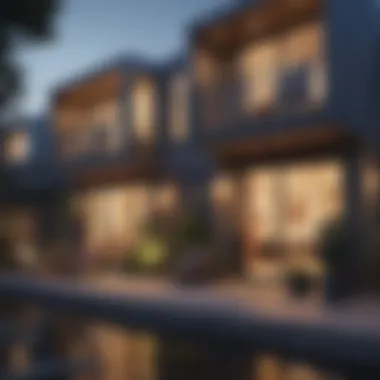Exploring Micro Housing Units: A Comprehensive Overview


Intro
Micro housing units have emerged as a significant response to growing urban housing shortages. These compact living spaces offer a solution not only to affordability but also to the desire for minimalist living. This article seeks to provide a thorough understanding of micro housing, from its architectural innovations to the challenges it poses in urban settings.
The concept of living small has gained traction across various demographics. Young professionals, retirees, and eco-conscious individuals are turning to these units for their functionality and simplicity. However, there are also complexities involved, such as zoning laws and community acceptance, which can hinder the widespread adoption of micro housing.
A detailed examination reveals how micro housing evolves in response to urbanization trends. By exploring design, functionality, and social implications, we can better appreciate this paradigm shift in urban living. The subsequent sections will delve deeper into specific aspects of micro housing units, showcasing exceptional designs and highlighting their cultural significance.
Preface to Micro Housing Units
The concept of micro housing units has emerged as a practical and innovative response to urban living challenges. The necessity for efficient space utilization, affordability, and sustainability has made these compact living environments particularly relevant. In a world where housing demands continue to grow due to urbanization, micro housing units stand at the intersection of design and necessity. Their relevance extends beyond mere shelter; they represent a shift towards thoughtful living, encouraging inhabitants to reconsider their spatial and environmental impact.
Definition and Characteristics
Micro housing units are defined as small, self-contained living spaces typically ranging from 100 to 400 square feet. These units often include essential amenities such as kitchens and bathrooms, allowing for functional day-to-day living. Key characteristics of micro housing include:
- Compact Design: Every inch matters, as the design prioritizes efficiency and multipurpose functionality.
- Sustainability: Many micro housing units incorporate sustainable practices, such as energy-efficient appliances and eco-friendly materials.
- Affordability: Due to their size, micro units often have lower rental or purchase prices compared to traditional homes, appealing to individuals seeking affordable options.
- Community-oriented: Many developments emphasize shared spaces, fostering social interaction among residents.
These elements combine to create a unique living experience tailored for modern urban dwellers.
Historical Context
The trend of micro housing is not entirely new. Its roots can be traced back to various housing movements over the decades. In post-World War II eras, smaller homes were seen as a solution to housing shortages. However, the recent surge in interest aligns with broader societal changes. In the 21st century, increased urbanization has intensified housing crises in cities across the globe, spurring the development of innovative choices like micro homes.
In Japanese culture, for example, the concept of small living spaces has long been integrated into urban life, with efficient layouts being a staple in metropolitan areas. Recently, cities like San Francisco, New York, and Tokyo have embraced micro housing as a means to tackle their growing population and accompanying housing demand.
The historical context provides essential insight into how micro housing units have evolved to meet contemporary needs. By examining these layers, we gain a clearer understanding of their significance in today’s urban landscape.
"Micro housing is not just about living small; it’s about living smart and sustainably in an age of increasing urban complexity."
The Rise of Micro Housing
Micro housing has increasingly gained attention in recent years. This rise is a reflection of various societal shifts. As cities expand, traditional housing options face difficulties in meeting the growing demand. Micro housing addresses these challenges by offering compact, flexible living solutions that are both innovative and practical. Through examining this phenomenon, we can gain insight into its significance and potential role in the future of urban areas.
Urbanization and Housing Demand
Urbanization is a defining trend of the 21st century. Over half of the world's population now resides in urban areas, and this number is projected to continue climbing. In many places, the demand for housing in cities surpasses the available supply. High property prices and rental costs lead many people to search for alternative living arrangements.
Micro housing emerges as a viable solution for these issues. It provides a means to accommodate individuals and families at various income levels. By making efficient use of limited space, micro units can deliver key amenities while maintaining affordability. Cities like Tokyo and New York have started embracing these units to combat rising costs.
Key factors include:
- Compact living arrangements that make the best use of limited space
- Affordability in areas where traditional homes are out of reach
- Flexibility that allows living solutions to adapt to diverse needs
Economic Factors Driving Micro Housing
The economic landscape plays a critical role in the rise of micro housing. Currently, several factors contribute to its growth:


- Cost of living: In cities with high living costs, micro housing provides an alternative, enabling individuals to afford a place without the burden of high rents.
- Investment opportunities: Real estate developers are increasingly interested in building micro housing units. These projects often yield high returns due to the ongoing demand for affordable options.
- Environmental sustainability: Consumers are becoming more aware of their environmental impact. Micro housing often features sustainable design and materials, appealing to eco-conscious individuals.
"Micro housing not only addresses current housing shortages but also aligns with modern values of sustainability and community engagement."
Micro housing represents a smart response to many challenges, including economic pressures and societal shifts. Its design and essence perfectly cater to urban preoccupations in the present and foreseeable future.
Design Principles of Micro Housing
Micro housing design principles are crucial in maximizing the value and functionality of limited space. These principles guide architects, designers, and builders in creating efficient yet livable environments. The focus is not only on aesthetics but also on creating spaces that meet the needs of their occupants. As urban populations grow, understanding these principles becomes more significant.
Maximizing Space Efficiency
Maximizing space efficiency is fundamental in micro housing. Most units typically range from 100 to 400 square feet. This limitation means every square inch must be utilized wisely. Designers often employ innovative solutions such as multi-functional furniture. For instance, a bed that can fold into the wall or a dining table that can double as a work desk are popular choices.
Another strategy relates to open floor plans. These layouts minimize barriers between living areas, which creates a sense of spaciousness. Vertical storage solutions are also effective; racks and shelves can utilize wall space without crowding the floor.
The integration of smart home technology further enhances space efficiency. Devices like smart thermostats and automated lighting simplify managing a smaller area. Therefore, when designed thoughtfully, micro units can feel more spacious than their actual square footage might suggest.
Sustainable Materials and Practices
Sustainability is becoming increasingly essential in today's housing designs. Micro housing units benefit from the use of eco-friendly materials. Many builders are opting for reclaimed wood, sustainable bamboo, and recycled metals. These materials not only minimize environmental impact but also contribute to a unique aesthetic.
Incorporating energy efficiency into these units is equally important. Well-insulated walls, energy-efficient appliances, and solar panels can drastically reduce energy consumption. These features make micro homes more affordable in the long term, providing cost savings to residents.
Additionally, implementing water-saving fixtures and rainwater harvesting systems can enhance sustainability. Adopting these practices contributes to an overall reduction in the ecological footprint of the housing sector.
Innovative Interior Layouts
Innovative interior layouts distinguish micro housing from traditional homes. Given the space constraints, designers often think creatively about how to partition living areas. Sliding doors or movable walls allow occupants to reconfigure their space based on needs, providing flexibility.
Moreover, loft designs are popular. They take advantage of vertical space, allowing for sleeping areas to be elevated while living areas remain below. This design effectively separates spaces without compromising the open-floor feel.
Smart storage solutions are vital in these layouts as well. Utilizing under-bed storage or custom cabinetry helps minimize clutter while maximizing functionality.
By focusing on innovative design principles, micro housing units can become an efficient, sustainable, and aesthetically pleasing solution to urban living problems.
Through the careful application of these elements, micro housing can thrive in modern environments, providing not just living space but an entirely new way of life.
Benefits of Micro Housing Units
Micro housing units present a range of advantages that are particularly relevant in today’s urban environments. The concepts of affordability, community interaction, and flexibility are key elements that make micro housing a viable solution to many pressing housing challenges. These units not only offer a strategic response to increasing urban density but also provide opportunities for innovative living arrangements that can meet diverse lifestyle needs.
Affordability and Accessibility
One of the most significant benefits of micro housing units is their affordability. Traditional housing models often come with high costs that can be prohibitive for many individuals and families. Micro housing addresses this issue by providing smaller living spaces at lower prices. This affordability makes homeownership more accessible to younger generations, students, and low-income individuals.
- Reduced Construction Costs: Smaller footprints mean lower material and labor costs, which can often lead to lower prices for buyers or renters.
- Lower Utility Costs: Micro units tend to consume less energy and resources, contributing to lower monthly expenses. This can enhance financial stability for residents.
In areas where housing demand continues to soar, micro housing serves as a practical alternative. It enables a wider demographic to live comfortably within urban settings, ensuring that more people can participate in city life without overwhelming financial burdens.


Community and Social Interaction
Another compelling aspect of micro housing is its potential to foster community connections. These units are typically designed within collaborative environments, encouraging interaction among residents.
- Shared Spaces: Many micro housing developments integrate communal spaces, such as kitchens, lounges, and gardens. Such designs promote socializing and create opportunities for relationship-building among neighbors.
- Diverse Populations: Micro units can attract a mix of residents, allowing for vibrant communities where individuals from various backgrounds interact, share experiences, and learn from one another.
This social dimension is essential in mitigating isolation, which can be a challenge in urban living, especially for newcomers and those who live alone.
Flexibility and Mobility Options
Flexibility is another benefit closely tied to micro housing. These designs typically cater to a dynamic lifestyle, appealing to those who value mobility and adaptability.
- Easily Relocatable: Many micro housing units, especially those designed as tiny homes, can be transported from one location to another. This feature is particularly attractive for individuals seeking to explore new cities or environments without the long-term commitment of traditional housing.
- Versatile Living Arrangements: Micro units can be configured for different uses, whether as a primary residence, a home office, or a guest house. This adaptability can cater to changing life circumstances or the need for multi-functional spaces.
"Micro housing units not only offer a solution to urban housing challenges but also support a lifestyle that values connection and flexibility."
Overall, the benefits of micro housing units extend beyond simple living arrangements. They address urgent economic, social, and practical needs within the urban landscape. By adopting these innovative housing solutions, communities can cultivate environments that are both livable and sustainable.
Challenges Associated with Micro Housing
Micro housing units represent a solution to significant urban challenges, including space shortages and rising housing costs. However, adopting this housing model presents several challenges that must be addressed to enhance their viability. Understanding these challenges is crucial for stakeholders ranging from city planners and developers to potential residents.
Regulatory and Zoning Issues
Regulatory hurdles often create barriers to the development of micro housing. Local laws vary widely and can be restrictive. For example, some municipalities may have minimum square footage requirements for residential units, which directly conflicts with the concept of micro homes. Additionally, zoning laws may not facilitate the integration of micro units into existing neighborhoods. As a result, developers face obstacles in securing permits and aligning their projects with local governance frameworks.
Local governments need to reconsider these regulations to encourage innovative housing solutions. By creating more flexible zoning laws and allowing for mixed-use developments, cities can create environments in which micro housing can thrive, benefiting the overall housing ecosystem.
Public Perception and Stigma
Public perception plays a significant role in the success of micro housing units. Unfortunately, many view these units as substandard or only suitable for the economically disadvantaged. This stigma can lead to opposition from residents in areas where micro housing projects are proposed.
Educating the public about the benefits of micro housing is essential. These units can promote sustainable living, reduction of clutter, and a community-focused lifestyle. By changing the narrative and showcasing successful micro housing developments, proponents can help the public see them not as a last resort but as a desirable and efficient living option.
Functionality vs. Aesthetics
Balancing functionality and aesthetics is another challenge in the micro housing arena. While the primary goal of micro housing is to maximize living space, there is also an expectation that these units will be visually appealing. Achieving both can be complex. Space-constrained designs may compromise comfort, while designs aimed at beauty may not utilize the space effectively.
Innovative design solutions are necessary to address this issue. Integrating multifunctional furniture can enhance the usability of small spaces without sacrificing style. Designers must focus on creating not just spaces that meet basic living needs but also environments that foster comfort and aesthetic pleasure.
"Micro housing can transform urban living, but addressing these challenges is key to their success."
To summarize, while micro housing units offer opportunities to tackle modern housing issues, challenges such as regulatory constraints, public perception, and aesthetic/functionality balance must be addressed. By prioritizing these aspects, stakeholders can pave the way for more successful micro housing initiatives.
Case Studies: Successful Micro Housing Initiatives
Case studies serve as vital reference points to understand the application of micro housing concepts in real-world settings. They provide insights into how these units are constructed and the impacts they have on the communities surrounding them. By examining specific initiatives across the globe, we can discern successful design practices, community engagement levels, and economic viability. Not only do these case studies illustrate the adaptability of micro housing, but they also highlight various challenges these initiatives may face. This section will delve into two key facets: innovative designs that have emerged globally and their tangible impacts on local communities.
Innovative Designs Around the World


The globe has seen a surge in micro housing designs that reflect both cultural influences and regional needs. Here are a few notable examples:
- Breezehouse in San Francisco: This project leverages sustainable materials and energy-efficient technologies. The design emphasizes airflow, reducing dependency on air conditioning.
- The Tiny House Movement in the US: This has exploded into a cultural phenomenon where homes are often movable and built on trailers. These homes can be customized according to individual needs while minimizing space.
- Nido\u2019s in Barcelona: Designed for student living, this initiative offers compact, well-organized units that prioritize communal living space.
These examples underline the diversity and creativity that can exist within the micro housing sector. Each project utilizes limited space effectively while catering to the particular needs of its residents.
Impact on Local Communities
The social, economic, and environmental effects of micro housing initiatives extend far beyond the individual units themselves. Here are some notable impacts:
- Affordable Living Solutions: Many micro housing projects provide affordable options for low-income families or individuals, allowing them to reside in areas with high living costs.
- Enhanced Community Interaction: Projects that incorporate shared spaces encourage neighbors to interact and build relationships, fostering a sense of community.
- Environmental Sustainability: By utilizing eco-friendly construction methods, these initiatives promote a lower carbon footprint and sustainable living practices.
"Micro housing is not just about living space; it embodies a lifestyle that encourages minimalism, community, and sustainability."
The successful integration of micro housing into communities can stimulate local economies and provide essential services that improve residents' quality of life. However, challenges remain, including regulatory hurdles and public misconceptions about living in smaller spaces. As micro housing continues to evolve, the lessons learned from these case studies will be vital for future developments.
Future Trends in Micro Housing
Future trends in micro housing units represent a significant area of interest for urban planners, real estate professionals, and individuals looking for viable living alternatives in increasingly crowded cities. As the population grows and urban spaces become more limited, finding effective solutions for housing is crucial. Micro housing not only addresses housing shortages but also promotes a more sustainable lifestyle. The forthcoming innovations point towards a shift in how we perceive living spaces.
Technological Innovations
Technology is driving the evolution of micro housing units. Smart home technologies allow residents to optimize their small spaces better. Devices like smart thermostats, energy-efficient appliances, and automated lighting systems promote efficient energy use, which is critical in micro living environments. Connecting these technologies to mobile applications enables users to monitor and manage their homes remotely, enhancing convenience and security.
Additionally, 3D printing has begun to play a role in this sector. It enables the rapid construction of homes with reduced waste and labor costs. This approach is not only more sustainable but also allows for unique designs that traditional construction methods cannot achieve. By adopting modular design principles, developers can create flexible living solutions that can adapt to the needs of residents as they change over time.
"Technology is transforming micro housing, making it more efficient and accessible than ever before."
Finally, the rise of virtual reality (VR) offers significant potential for showcasing micro housing units. Prospective buyers can experience layouts and designs without the need for physical visits. Such advancements are reshaping the marketing and buying processes in this niche.
Global Perspectives on Micro Living
Micro housing concepts are emerging globally, reflecting cultural differences and local needs. For instance, in Japan, the concept of “tiny house” living has gained traction as a response to high property prices and limited space. Japanese architects often incorporate multi-functional furniture and sliding walls to optimize space, resulting in innovative and functional homes.
In contrast, cities like Berlin and New York are exploring micro housing as solutions for affordability and homelessness. Initiatives in these urban areas involve creating small units to house vulnerable populations while encouraging community-building through shared spaces.
Understanding various perspectives on micro living is essential. It highlights how different cultures adapt to similar challenges through distinct approaches, enhancing the overall dialogue about urban living.
As we look to the future, micro housing units will likely evolve with an increased focus on sustainability, technology integration, and community-centric designs. These trends are not just innovative; they are essential to creating living spaces that are both practical and responsive to the needs of today’s urban dwellers.
Epilogue
In summarizing the insights gained throughout this exploration of micro housing units, it is clear that this innovative approach has significant implications for urban living. Micro housing is a practical response to housing shortages, offering solutions tailored for increasing urban population densities. The role of these units extends beyond mere shelter; they represent a shift towards more sustainable, community-driven living environments.
The Role of Micro Housing in Future Cities
Micro housing plays an integral part in shaping future cities. As urban centers expand, the demand for affordable, efficient living spaces grows. Micro housing offers a viable alternative, characterized by compact designs that maximize utility without compromising quality of life. By integrating green materials and innovative design principles, these units are adaptable to different contexts, accommodating a diverse range of residents.
Moreover, micro housing fosters community building. When clustered in neighborhoods, they create an environment that encourages social interaction and cooperation among residents. This community aspect is vital in countering urban isolation, promoting a sense of belonging in densely populated areas. Furthermore, they often support local economies, as smaller units can be developed in previously neglected areas, revitalizing communities.
Final Thoughts and Recommendations
As we move forward, it is essential to embrace the micro housing trend thoughtfully. This includes advocating for policies that support regulatory changes, which can facilitate the development of these units. Cities should consider revising zoning laws and building codes to accommodate the unique features of micro housing, making it easier for developers to innovate.
In addition to policy changes, public perception needs addressing. Community education campaigns can combat stigma around micro housing and highlight the benefits of living in such environments. By showcasing successful case studies and the positive impacts on existing communities, individuals and local governments can foster acceptance.







